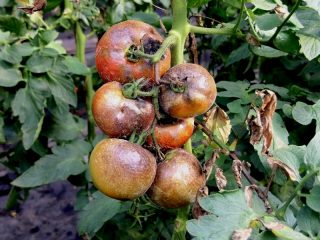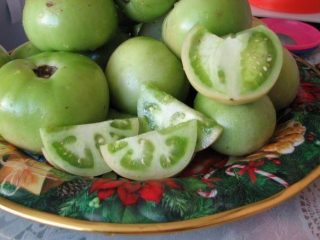Content
Tomatoes are a vegetable that almost everyone loves. Red, crimson, pink, yellow and white, black, brown and even green - but ripe! These berries are just begging to be tasted. In order for tomatoes to grow tasty and ripen on the bush, they need a lot of sun and warmth. In the south, everything is very simple - you sow it in the ground, and then just take care of it. But in the middle zone, and even more so in the north, this will not work.
The number of varieties that can be grown without seedlings is small, and they do not have time to fully yield the entire possible harvest during our short and not very generous summer. So you have to grow seedlings, tend and nurture them, water them, feed them, and nurture them. Typically, fertilizing with a complete soluble complex mineral fertilizer is practiced. But it does not contain one of the essential elements for tomatoes - iodine.
In this case, only one drop of iodine is used per two liters of water. Each plant is watered with a small amount of this solution.After such feeding, the plants become stronger, and the flower clusters that form in the future become more branched.
It seemed that just recently the seedlings were tiny, but stable spring warmth had already arrived and it was time for the seedlings to move to the dacha. The conditions of all gardeners are different - some have a good-quality greenhouse under polycarbonate, while others have a small greenhouse under a film. Many people plant seedlings directly into the ground, hoping that hardy varieties will adapt to any conditions. But no matter where tomatoes grow, they equally require care and proper care. Every gardener can do a lot for his favorite tomatoes: water them on time, feed them, remove shoots, but it is not in his power to provide his wards with optimal weather. Our unpredictable summer is full of surprises: either endless rain or sudden cold snaps. It is not easy for such a heat-loving crop as tomatoes to grow in extreme conditions. Plants' immunity decreases. This means that illness is not far off.
When signs appear on plants diseases, it will be much more difficult to cope with them.
Ways to combat tomato diseases
Disease prevention should take two routes.
- Strengthening plant immunity.
- Fighting possible pathogens to prevent not only their spread, but even their appearance.
Strengthening plant immunity
Plant immunity can be strengthened with the help of immunostimulants. There are a number of drugs that not only increase the resistance of plants, but also significantly increase the yield and improve its quality.One of these substances is immunocytophyte.
This is a domestic drug. Before the use of immunocytophyte was allowed, its harmlessness and effect on plants was tested for several years specifically on tomatoes. Tests were carried out by the Department of Phytopathology of SSAU named after. Vavilova. Their result was a conclusion about complete safety not only for humans, but also for animals and even insects. And this is understandable - the preparation contains the optimal combination of substances beneficial to plants and harmless to humans: arachidonic acid, which is not only found in some vegetable oils, but is also added to breast milk substitute mixtures, antioxidants - substances that do not need to be recommended, a number of esters based on ethyl alcohol and some high molecular weight fatty acids. The main component of immunocytophyte is ordinary urea, a well-known nitrogen fertilizer. But the effective effect of the drug is due not only to these components. Immunocytophyte contains a substance that is the result of the vital activity of a number of plant pathogenic microorganisms. In small doses, it acts on them in the same way as a vaccination against a disease on a person, developing the ability to resist these diseases in the future.
This drug is especially effective in creating immunity to late blight, the most dangerous disease.
Signs and causes of late blight
Late blight is caused by phytopathogenic fungal microorganisms.Plants from the nightshade family and even strawberries are susceptible to it, about forty plant species in total. But if in potatoes, when signs of the disease appear on the leaves, the tubers may not have time to be affected before harvesting, then in tomatoes, late blight often takes on a hurricane character and can destroy the entire crop in just a few days. A characteristic sign of the disease is the appearance of brown spots, first on the stems, then on the leaves, and then on the fruits of the plants. The appearance and rapid spread of the disease is facilitated by planting potatoes close to tomatoes, increased humidity of both soil and air, non-compliance with crop rotation, crowding of plants, improper watering, and abuse of nitrogen fertilizers.
In order to prevent the pathogen from appearing on plants, different methods of processing tomatoes can be used. One of the fairly simple, but nevertheless quite effective, is spraying tomatoes with iodine. One of the big advantages of this processing is that it is harmless to humans. There is no need to wait three weeks after processing to taste ripe tomatoes.
Benefits of iodine for tomatoes
Iodine in small doses is necessary for all plants. Most of them have enough of the amount of this element that is present in the soil. But it is not enough for tomatoes. Outwardly, iodine deficiency has almost no effect on the plant and the gardener may not even realize that the plants lack it. But a lack of this element can lead to a slowdown in metabolic processes, in particular, the degree of nitrogen absorption deteriorates, the growth of the plant itself and the ripening of fruits are inhibited. Iodine is a microfertilizer, so its norms for fertilizing are small.
Root feeding with solutions containing iodine
Feeding with this element can be combined with the addition of other nutrients in liquid form, adding three to ten drops of 5% iodine tincture to the nutrient solution for every ten liters. The number of drops increases as the tomatoes themselves grow. This is root feeding. It is carried out no more often than once every fifteen days. During the gardening season, you can carry out up to four such feedings. Five liters of solution are consumed for every square meter. Water the plants at the roots, wetting the soil around them. With such processing tomato iodine destroys pathogenic fungi located on the soil surface.
Combining foliar fertilizing with iodine with late blight treatment
Good for the development of tomatoes foliar feeding with iodine. It is better to carry them out on the waxing moon, when the above-ground part of the plant absorbs nutrients as much as possible. Spraying tomatoes with iodine not only provides additional nutrition to the plants, it is an excellent prevention of late blight. The best effect is obtained by adding milk or whey to the iodine solution, which is also a good remedy for this disease.
Working solution proportions:
- whey or milk, preferably not pasteurized, one liter;
- iodine – fifteen drops;
- water - four liters.
It is possible to spray only with serum without adding iodine. It is diluted in a one to one ratio.
It is advisable that there be no rain for several days after treatment. Iodine foliar prevention of late blight can be carried out no more often than once every fifteen days. But treatment with a solution of milk or whey is carried out as needed, at least every day. It does not harm plants, while providing them with additional nutrition and even improving their growth. The milk film is unstable because it is washed away by rain.
Treatment of tomatoes with iodine in the greenhouse and outdoors
Foliar treatments should be carried out starting a couple of weeks after planting and ending at the end of August. By this time determinate tomatoes, grown in open ground, are already finishing their growing season. Spraying tomatoes iodine in a greenhouse and in open ground is carried out differently. There is no natural precipitation in the greenhouse; all moisture is brought in only by gardeners. As a result, the solution remains on the plant after treatment. In the greenhouse for tomatoes There is always slightly less moisture received than in the open air, so nutrients are washed into the lower layers of the soil less intensively.
But foliar feeding in the greenhouse should be carried out in September. Indeterminate tomatoes in the greenhouse grow and bear fruit until frost, and the weather in September is already cool, which increases the risk of developing late blight.
But it’s better not to limit yourself to this and additionally carry out fertilizing and processing according to all the rules. Based on iodine and whey, there is another recipe that allows you to effectively fight late blight on tomatoes while simultaneously feeding the plants. This is discussed in detail in this video.
Late blight is a dangerous disease, but it is quite possible to combat it successfully, or even better, simply not allow it into your area. Preventive spraying of tomatoes with iodine will be a good help in this.















